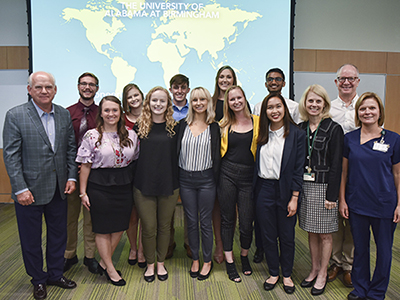By Christina Crowe
Sepsis is a deadly infection that kills hundreds of thousands of people annually and costs billions of dollars, according to the U.S. Department of Health and Human Services. What if a group of students could design a program to reduce both the mortality rate and high cost of treating this life-threatening condition?
 Biomedical engineering students Olivia Shivers, Kyla Luechtefeld and Jeteesh Kunche were among 10 Presidential Summer Clinical Innovation Fellows in 2019. Photo by Frank Couch.For each of the past three years, UAB President Ray Watts, M.D., has tasked a select group of undergraduate students with this challenge, and on Monday, August 12, they gathered before Watts and faculty from the Schools of Nursing and Engineering and the Honors College to present their unique solutions to sepsis.
Biomedical engineering students Olivia Shivers, Kyla Luechtefeld and Jeteesh Kunche were among 10 Presidential Summer Clinical Innovation Fellows in 2019. Photo by Frank Couch.For each of the past three years, UAB President Ray Watts, M.D., has tasked a select group of undergraduate students with this challenge, and on Monday, August 12, they gathered before Watts and faculty from the Schools of Nursing and Engineering and the Honors College to present their unique solutions to sepsis.
The Presidential Summer Clinical Innovation Fellows are part of a unique cohort supported by the UAB Office of the President to innovate solutions to the problem of early identification of sepsis, a potentially life-threatening condition caused by the body’s response to infection.
The earlier sepsis can be identified, the better the patient’s chance to combat it. These ten students—five from the Honors College and five from the School of Nursing—worked together for 10 weeks over the summer to define the problem and identify both an education intervention and a wearable solution.
The fellows split into two teams to design two methods to combat the issue of nurse education of the early symptoms of sepsis. The first group created a self-contained virtual reality (VR) program to allow nurses a place to practice on virtual patients, without fear of making potentially dangerous or costly mistakes.
Students worked with the Utah Valley University Animation and Game Department to design software that simulates various patient scenarios and allows the user to take actions and make choices to affect the patient’s diagnosis and treatment. The ultimate goal of this interface is to design tabletop simulated patients for the nurses to work with in the VR program. The team said they hope to “play test” the tool at UAB in spring 2020, test the final game in May, and by July begin implementation in a clinical setting.
The second team of fellows designed a wearable device for continuous monitoring that provides constant contact with the patient. The CleVie (a mashup of the French word “clé,” meaning key and “vie,” meaning life) is a small, flexible sensor that sits above the ear on the temporal lobe and can monitor vital signs. This device will continuously monitor and report on key indicators of a patient’s health that, if varying from normal levels can indicate early symptoms of sepsis.
The fellowship program is a product of UAB Solution Studios®, a partnership between the UAB Schools of Engineering and Nursing, the Honors College, and UAB Hospital with Support from the Office of the President and the Bill L. Harbert Institute for Innovation and Entrepreneurship.
Three of the program’s Honors College students are pursuing degrees in the Department of Biomedical Engineering: Olivia Shivers, Kyla Luechtefeld and Jeteesh Kunche. BME faculty Alan Eberhardt, Ph.D., Professor and Associate Chair, and Joel Berry, Ph.D., Associate Professor, advise the fellows throughout the program and have been involved with the program since its inception.
“The Innovation Fellows are getting truly novel experiences interacting with UAB clinicians on critical problems and coming up with exciting and innovative solutions,” says Eberhardt. “These activities set a new bar for education.”
Nancy Wingo, Ph.D., Assistant Professor, Nursing and Director of Instructional Innovation, and advisor for the program, agrees.
“These undergraduate students showed tremendous drive, creativity, and passion as they collaborated in interprofessional teams this summer to tackle the complex problem of sepsis. We are committed to helping them move these projects forward to enhance patient care at UAB and beyond,” she says.
The program doubled in size this year from five to 10 participating students.
Details about the fellowship program: https://www.uab.edu/solutionstudios/summer-fellowship-program.